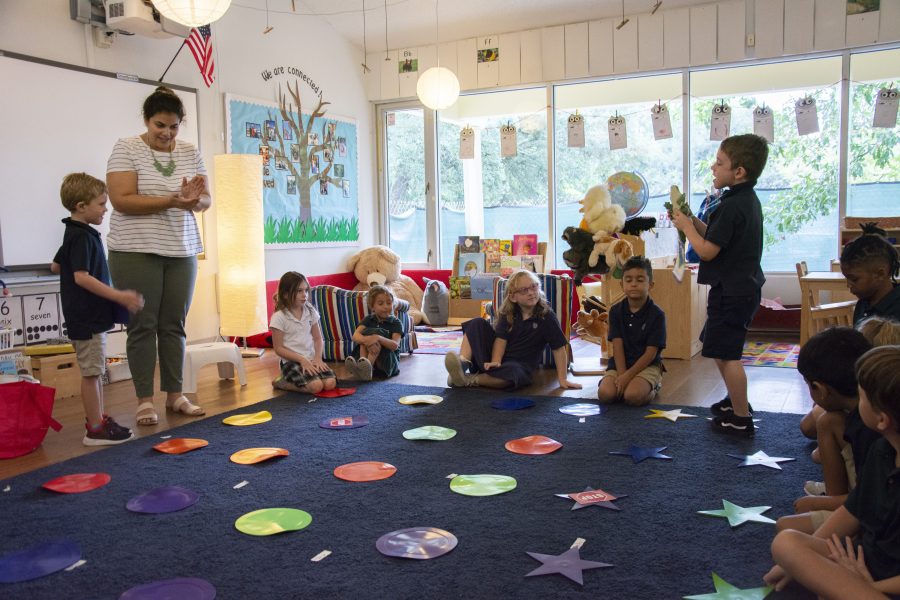
As the Computer Science Specialist at Jacksonville Country Day School, I am often amazed at how teaching methods have changed considerably since I first began.
When I think back to my first year of teaching in the “computer lab” 11 years ago (WOW!), I can hear myself uttering phrases that I wouldn’t dare use today because they’re already outdated. What and how I teach has changed dramatically in 11 years. I began working with 2nd graders on creating a pamphlet in Microsoft Word, and now I am teaching kindergartners to program robots to move around obstacles on a mat!
Looking back, I’ve always loved technology. I enjoy the problem-solving and creative freedom that comes with programming, and my goal has always been to create an environment where students can feel the same. As technology rapidly progresses, I’m constantly asking myself, “What can I do to best prepare these students for a future that changes so fast, it can’t be predicted?” According to code.org, 67% of all new jobs in STEM are computing, but only 11% of STEM Bachelor’s degrees are in computer science. How can I help our elementary school students gain the skills necessary for a future that will become increasingly reliant on technology? Because, after all, technology skill acquisition is just like language acquisition, and it is necessary for all students to be comfortable with this ever-evolving medium.
Computational Thinking
When it comes to creating this new future for our kids, laying a solid educational foundation in young children is crucial, and it’s the job with which all elementary school teachers are tasked. In our Tech and Design Studio (no longer just a computer lab!), as it is now called, I begin by teaching young children how to use computational thinking. This means training your brain to understand problems by identifying patterns and thinking logically to find and create solutions. This can be hard for young children, who don’t normally slow down to stop and think. I see this in my own child, who at 4 years old gets frustrated when she can’t get her doll unstuck from the slats in her bed frame. I’ll try and fight the urge to remove the doll for her (which is hard for me!), and instead, I’ll have her stop and look at the problem. We determine that the doll’s head is too wide, so she needs to rotate it in a vertical position so it can be removed. Voila! She just used computational thinking at a basic level.
But how do we cultivate this computational thinking in young learners? I start by introducing kinesthetic activities such as “programming” our friend (the computer) to find a hidden object in the room or giving a set of directions to walk through a maze. By using their bodies to physically act out the directions, just as a computer does, it helps them to understand how to execute an algorithm (a set of directions). As they progress through their time here at JCDS, I can see the growth, and I’m blown away by what they can do when they graduate as sixth graders.

Freedom to Fail
Another key factor in fostering computational thinking is allowing students the freedom to fail. As parents, it can be hard to watch our kids struggle. In the classroom, just as I do with my own children, I have to resist doing things for the students, because even if I know it won’t work, they must learn that not always getting it right is a key component to their learning. In our classrooms, we encourage children to try, even if they don’t get it right the first few times. We foster an environment where students feel safe to make mistakes, so they’ll be more encouraged to try solving a problem in multiple ways instead of getting discouraged and quitting.
Perseverance
The freedom to fail leads to perseverance. I’ve noticed that the more we foster a safe environment, the more willing students are to take risks. If they have an idea about how to program their LEGO robot to perform an action, I’ll encourage them to write their program and test it out. If it didn’t work, I ask them to question why, then we break it down, think it through, and try something else. Sometimes, a student might have to change their program 15 times before it works. Their tenacity helps lead them to success, and I can tell how proud they are when they finally get it and see them high-five and cheer!
Coding for the Future
Many of the projects our students do here at JCDS tie in with our character education program. How does empathy tie in with technology? Think about how much technology improves your life every day! For example, there are apps that help vision-impaired people by reading a restaurant menu to them. There’s also speech-to-text apps that help those who have difficulty writing or using a pencil. The ability to create something that helps people in their daily life accomplish things that others may take for granted is an ideology that we encourage.
Recently, our 4th graders were learning about the International Space Station and what life would be like for a person living in space. They looked at problems astronauts might face and then chose a problem to solve. One group used our present COVID-19 crisis as the basis of their idea. What if an astronaut gets sick and has to quarantine? How would they get their medicine? They designed a robotic dog using our LEGO kits and programmed it to deliver medicine to a sick astronaut. This is exactly what we want from our students — young people who can think of problems others might face, break them down, persevere through challenges, and ultimately create a solution that has the power to change the world.
About the Author
 Cristina Sanchez-Knodel is a Computer Science Specialist at Jacksonville Country Day School. She has a Bachelor’s Degree in Elementary Education and a Master’s Degree in Elementary Education and Instructional Technology, both from the University of North Florida. Professional development includes attending the Innovation Institute at Pine Crest School, and the Design Thinking Workshop at The Mount Vernon School. This is her tenth year at JCDS. She’s been married to her husband Robert for 6 years and they have two children, ages 4 and 6 months.
Cristina Sanchez-Knodel is a Computer Science Specialist at Jacksonville Country Day School. She has a Bachelor’s Degree in Elementary Education and a Master’s Degree in Elementary Education and Instructional Technology, both from the University of North Florida. Professional development includes attending the Innovation Institute at Pine Crest School, and the Design Thinking Workshop at The Mount Vernon School. This is her tenth year at JCDS. She’s been married to her husband Robert for 6 years and they have two children, ages 4 and 6 months.

















It reminds me of expressions I have heard over the years of my life when “computers” were mechanical:
1- This machine does only one thing. What else can be done?
2- Then came machines that could add, subtract and print. Helpful.
3- Too slow. Need more speed. Build them with fast electric motors. Then mechanical
malfunctions annoyed people.
4- The vacuum tubes showed up. The heat made work uncomfortable and unbearable- .Required A/C. Welcome powerful and noisy air conditioners. The machine space needed was lager than a garage.
5. Finally the transistor showed up. Thank God!! Electronics conquered..